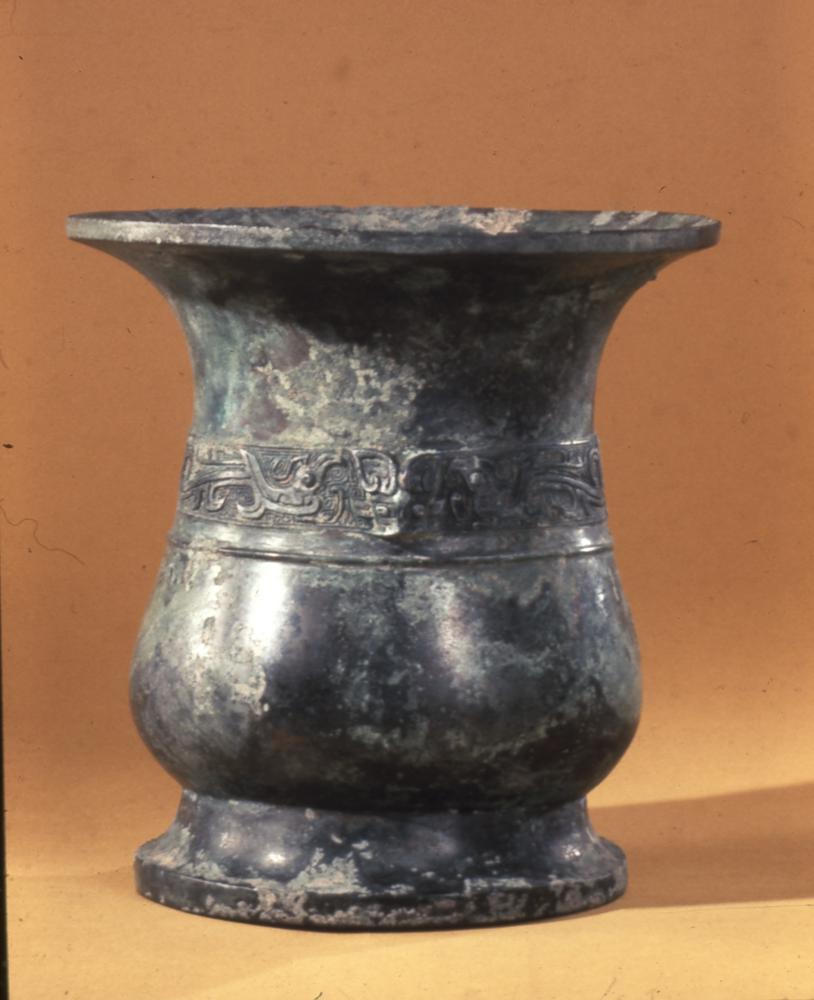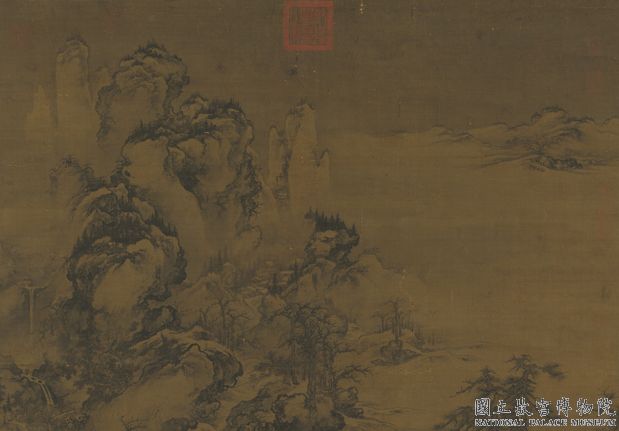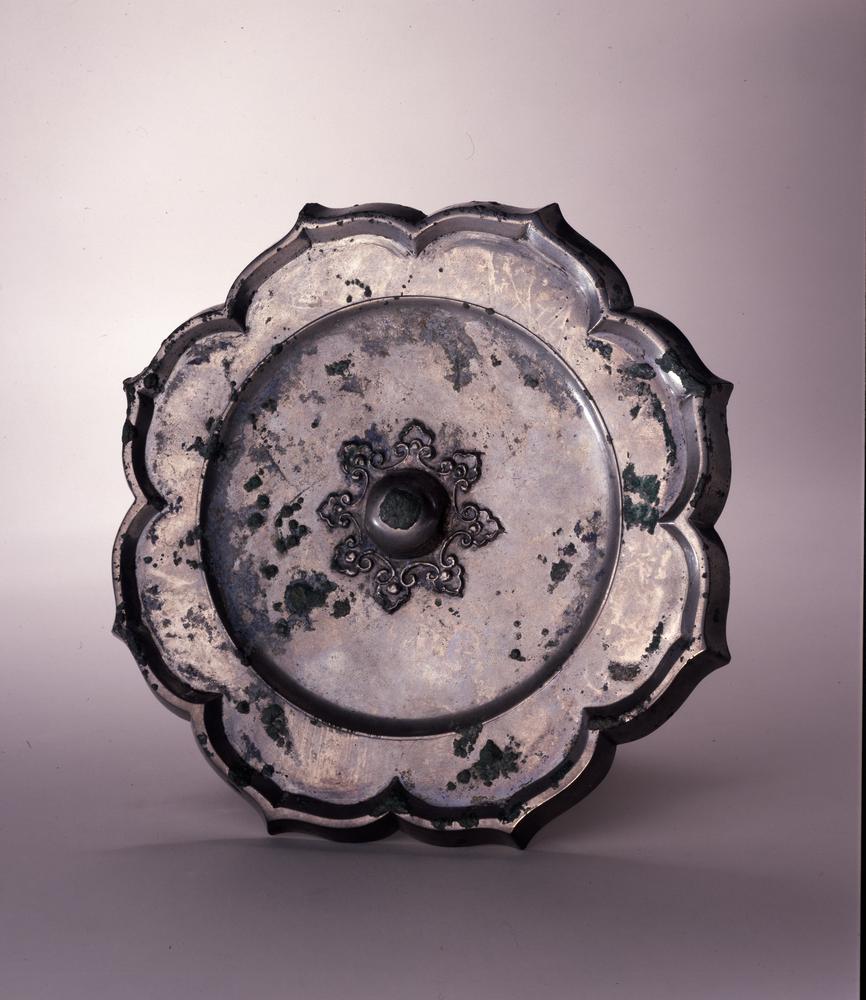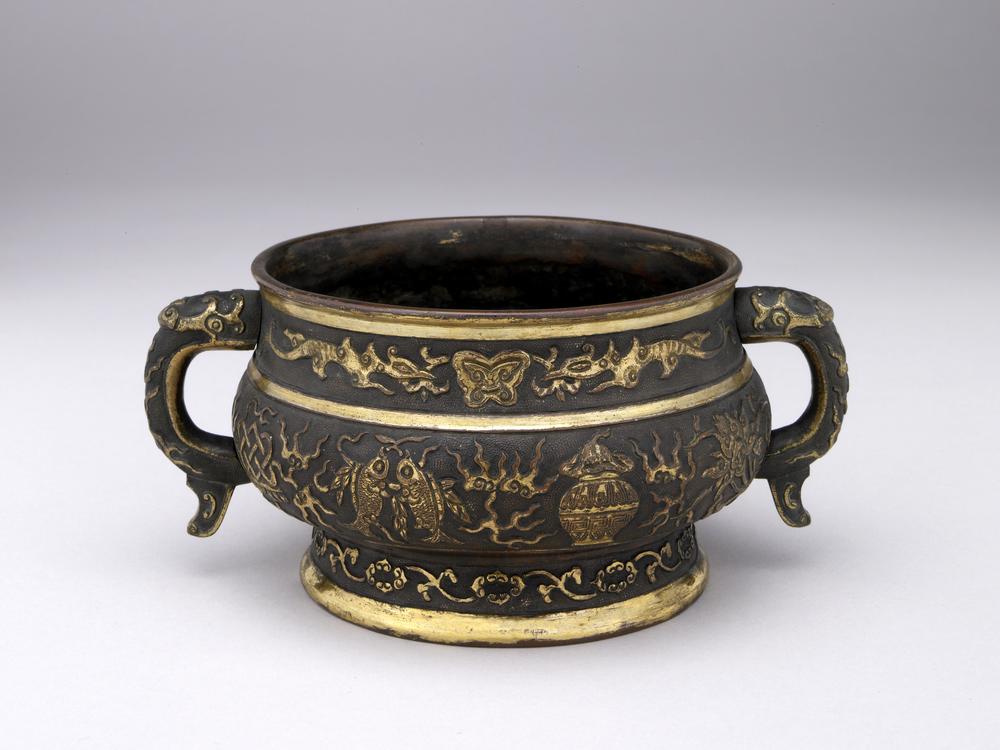Period:Unknown Production date:19thC(early)
Materials:silk
Technique:painted
Subjects:japanese chinese artistic life daily life procession plant animal deity festival landscape horse/ass
Dimensions:Height: 29.80 centimetres (scroll 1) Height: 29.80 centimetres (scroll 2) Width: 1048.50 centimetres (scroll 1) Width: 1007.40 centimetres (scroll 2)
Description:
Painting, pair of handscrolls. Miscellaneous pictures. Scroll 1, Chinese subjects: Chinese-style figure seated surrounded by reishi fungus; group of figures engaged in practising calligraphy and painting; carriage, horse, and various objects in procession; scholars pursuing verse-making, drinking wine, tea-drinking; arrowroot, morning glory, thoroughwort, hagi (Japanese bush clover), pinks, and ominaeshi (Valerianaceae); three dragonflies flying in sky; Daikokuten seated with bag and bale of rice beside him. Scroll 2, Japanese subjects: Ox Festival procession at Uzumasa in Kyoto; sumo wrestlers, monkey trainer, old peddler with goods on his shoulder, man selling tea whisks, farmers washing vegetables in river, men catching fish on seashore; tree branch bearing partly ripening fruit resembling akebi; black-and-white rabbit; autumn landscape with moon and winter landscape with snow; standing figure of Ebisu with large sea bream under his arm and fishing pole in his hand. Ink and light colour on silk. Signed and sealed.
IMG
![图片[1]-handscroll; painting BM-1981-0408-0.1-2-China Archive](https://chinaarchive.net/Unknown/Paintings/mid_00035918_001.jpg)
![图片[2]-handscroll; painting BM-1981-0408-0.1-2-China Archive](https://chinaarchive.net/Unknown/Paintings/mid_00780571_001.jpg)
![图片[3]-handscroll; painting BM-1981-0408-0.1-2-China Archive](https://chinaarchive.net/Unknown/Paintings/mid_00235813_001.jpg)
![图片[4]-handscroll; painting BM-1981-0408-0.1-2-China Archive](https://chinaarchive.net/Unknown/Paintings/mid_00525154_001.jpg)
Comments:Smith et al 1990This pair of handscrolls, a masterpiece among the few paintings by Bunpo so far published, demonstrates to us the cheerful artistic personality and dual worlds of interest of this brilliant stylist who worked in Kyoto in the early nineteenth century. One scroll shows Chinese subjects – elderly sages meeting to compose poetry, paint, drink and carouse – and the other, scenes at Japanese festivals and idyllic country landscapes. Bunpo dutifully studied Chinese paintings both directly and through the work of his teacher Kishi Ganku (1749-1838, nos 181 and 182) but temperamentally seems to have been drawn to the purely native, soft Shijo style that predominated in the Kyoto art world at the time. Though the wriggling line of his figure work echoes Ganku’s idiosyncratic style, the bold sense of placement and the warm humour with which the faces of the figures are distorted are entirely his own.In the scene reproduced a drunken scholar is supported by young acolytes, while an aged artist is poised to paint before a self-important official: despite the Chinese costumes one can imagine that parties held by painters and poets in Bunpo’s own Kyoto were equally convivial. The scroll of Japanese subjects includes the procession of the Uzumasa autumn festival, which also appears in the second (west) volume of Bunpo’s illustrated book ‘Teito gakei ichiran’ (‘Elegant Views of the Capital at a Glance’, 4 vols, 1809-16). Woefully unthreatening wearers of devil masks are followed by a huge blazing torch, while bringing up the rear is a group of solemn village farmers leading a reluctant ox on which sits a priest wearing the strangest of masks.FURTHER READING Hillier, Jack, “Kawamura Bumpo and Kawamura Kiho”, in ‘The Art of the Japanese Book’, London, 1987, pp. 686-703.See also: Hillier, Jack, ‘The Uninhibited Brush: Japanese Art in the Shijo style’, 1974, London, nos 183,184,185.Lane, Richard, “A Gallery of Ukiyo-e Paintings (XIV)”, ‘Ukiyo-e’ 64 (January), no. 511, p. 83. Hizo Nihon bijutsu taikan Vol 2Kawamura Bunpo (1779-1821), a Kyoto artist, studied under Ganku and is believed to have had contact with various other artists who influenced him in the formation of his own style. The human figures in the present scroll, for example, are basically in the style of Ganku but with influences from Goshun, while in the landscapes and flower-and-bird paintings one detects a neatly elegant, sketch-like style closer to that of the Maruyama-Shijo school. The first scroll begins with Chinese-style figures resembling Taoist immortals, surrounded by ‘reishi’ (a type of fungus with magical properties) (Color Plate 37-1). A group of figures engaged in practicing calligraphy and painting gives way, as the scroll advances, to a procession in which a carriage, a horse, and various objects make their appearance, followed by interior scenes in which scholars pursue various pastimes: verse-making, drinking wine, tea-drinking. Next come various autumnal flowers and grasses such as arrowroot, morning glory, thoroughwort, ‘hagi’ (Japanese bush clover), pinks, and ‘ominaeshi’ (Valerianaceae) (Color Plate 37-2), and beyond them again three dragonflies are seen flying in the sky. As the color plate shows, the light treatment here – the color applied sparingly with the tip of an upright brush – is reminiscent of the paintings of plants and flowers by Watanabe Nangaku, a pupil of Maruyama Okyo, and those of Sakai Hoitsu, the Edo artist who was influenced by Nangaku in turn. As such, this scene comes as a refreshing change from the earlier, somewhat heavy forms of the Chinese figures. The final picture on this first scroll shows Daikokuten seated with a bag and a bale of rice beside him.The second scroll portrays Japanese figures as a contrast to the Chinese figures of the first scroll. The first subject is the Ox Festival procession at Uzumasa in Kyoto (Color Plate 38-1). It is followed by various scenes from daily life in the capital and in the countryside – sumo wrestlers, a monkey trainer, an old peddler with goods on his shoulder, a man selling tea whisks, farmers washing vegetables in the river, and men catching fish on the seashore. Next comes a tree branch bearing partly ripening fruit resembling ‘akebi’, together with a black-and-white rabbit (Color Plate 38-2), and autumn and winter landscapes showing, respectively, a moonlit night and a snow scene. The scroll ends with a standing figure of Ebisu, seen from the side, with a large sea bream under his arm and a fishing pole in his hand.
Materials:silk
Technique:painted
Subjects:japanese chinese artistic life daily life procession plant animal deity festival landscape horse/ass
Dimensions:Height: 29.80 centimetres (scroll 1) Height: 29.80 centimetres (scroll 2) Width: 1048.50 centimetres (scroll 1) Width: 1007.40 centimetres (scroll 2)
Description:
Painting, pair of handscrolls. Miscellaneous pictures. Scroll 1, Chinese subjects: Chinese-style figure seated surrounded by reishi fungus; group of figures engaged in practising calligraphy and painting; carriage, horse, and various objects in procession; scholars pursuing verse-making, drinking wine, tea-drinking; arrowroot, morning glory, thoroughwort, hagi (Japanese bush clover), pinks, and ominaeshi (Valerianaceae); three dragonflies flying in sky; Daikokuten seated with bag and bale of rice beside him. Scroll 2, Japanese subjects: Ox Festival procession at Uzumasa in Kyoto; sumo wrestlers, monkey trainer, old peddler with goods on his shoulder, man selling tea whisks, farmers washing vegetables in river, men catching fish on seashore; tree branch bearing partly ripening fruit resembling akebi; black-and-white rabbit; autumn landscape with moon and winter landscape with snow; standing figure of Ebisu with large sea bream under his arm and fishing pole in his hand. Ink and light colour on silk. Signed and sealed.
IMG
![图片[1]-handscroll; painting BM-1981-0408-0.1-2-China Archive](https://chinaarchive.net/Unknown/Paintings/mid_00035918_001.jpg)
![图片[2]-handscroll; painting BM-1981-0408-0.1-2-China Archive](https://chinaarchive.net/Unknown/Paintings/mid_00780571_001.jpg)
![图片[3]-handscroll; painting BM-1981-0408-0.1-2-China Archive](https://chinaarchive.net/Unknown/Paintings/mid_00235813_001.jpg)
![图片[4]-handscroll; painting BM-1981-0408-0.1-2-China Archive](https://chinaarchive.net/Unknown/Paintings/mid_00525154_001.jpg)
Comments:Smith et al 1990This pair of handscrolls, a masterpiece among the few paintings by Bunpo so far published, demonstrates to us the cheerful artistic personality and dual worlds of interest of this brilliant stylist who worked in Kyoto in the early nineteenth century. One scroll shows Chinese subjects – elderly sages meeting to compose poetry, paint, drink and carouse – and the other, scenes at Japanese festivals and idyllic country landscapes. Bunpo dutifully studied Chinese paintings both directly and through the work of his teacher Kishi Ganku (1749-1838, nos 181 and 182) but temperamentally seems to have been drawn to the purely native, soft Shijo style that predominated in the Kyoto art world at the time. Though the wriggling line of his figure work echoes Ganku’s idiosyncratic style, the bold sense of placement and the warm humour with which the faces of the figures are distorted are entirely his own.In the scene reproduced a drunken scholar is supported by young acolytes, while an aged artist is poised to paint before a self-important official: despite the Chinese costumes one can imagine that parties held by painters and poets in Bunpo’s own Kyoto were equally convivial. The scroll of Japanese subjects includes the procession of the Uzumasa autumn festival, which also appears in the second (west) volume of Bunpo’s illustrated book ‘Teito gakei ichiran’ (‘Elegant Views of the Capital at a Glance’, 4 vols, 1809-16). Woefully unthreatening wearers of devil masks are followed by a huge blazing torch, while bringing up the rear is a group of solemn village farmers leading a reluctant ox on which sits a priest wearing the strangest of masks.FURTHER READING Hillier, Jack, “Kawamura Bumpo and Kawamura Kiho”, in ‘The Art of the Japanese Book’, London, 1987, pp. 686-703.See also: Hillier, Jack, ‘The Uninhibited Brush: Japanese Art in the Shijo style’, 1974, London, nos 183,184,185.Lane, Richard, “A Gallery of Ukiyo-e Paintings (XIV)”, ‘Ukiyo-e’ 64 (January), no. 511, p. 83. Hizo Nihon bijutsu taikan Vol 2Kawamura Bunpo (1779-1821), a Kyoto artist, studied under Ganku and is believed to have had contact with various other artists who influenced him in the formation of his own style. The human figures in the present scroll, for example, are basically in the style of Ganku but with influences from Goshun, while in the landscapes and flower-and-bird paintings one detects a neatly elegant, sketch-like style closer to that of the Maruyama-Shijo school. The first scroll begins with Chinese-style figures resembling Taoist immortals, surrounded by ‘reishi’ (a type of fungus with magical properties) (Color Plate 37-1). A group of figures engaged in practicing calligraphy and painting gives way, as the scroll advances, to a procession in which a carriage, a horse, and various objects make their appearance, followed by interior scenes in which scholars pursue various pastimes: verse-making, drinking wine, tea-drinking. Next come various autumnal flowers and grasses such as arrowroot, morning glory, thoroughwort, ‘hagi’ (Japanese bush clover), pinks, and ‘ominaeshi’ (Valerianaceae) (Color Plate 37-2), and beyond them again three dragonflies are seen flying in the sky. As the color plate shows, the light treatment here – the color applied sparingly with the tip of an upright brush – is reminiscent of the paintings of plants and flowers by Watanabe Nangaku, a pupil of Maruyama Okyo, and those of Sakai Hoitsu, the Edo artist who was influenced by Nangaku in turn. As such, this scene comes as a refreshing change from the earlier, somewhat heavy forms of the Chinese figures. The final picture on this first scroll shows Daikokuten seated with a bag and a bale of rice beside him.The second scroll portrays Japanese figures as a contrast to the Chinese figures of the first scroll. The first subject is the Ox Festival procession at Uzumasa in Kyoto (Color Plate 38-1). It is followed by various scenes from daily life in the capital and in the countryside – sumo wrestlers, a monkey trainer, an old peddler with goods on his shoulder, a man selling tea whisks, farmers washing vegetables in the river, and men catching fish on the seashore. Next comes a tree branch bearing partly ripening fruit resembling ‘akebi’, together with a black-and-white rabbit (Color Plate 38-2), and autumn and winter landscapes showing, respectively, a moonlit night and a snow scene. The scroll ends with a standing figure of Ebisu, seen from the side, with a large sea bream under his arm and a fishing pole in his hand.
© Copyright
The copyright of the article belongs to the author, please keep the original link for reprinting.
THE END
![[Qing Dynasty] British female painter—Elizabeth Keith, using woodblock prints to record China from the late Qing Dynasty to the early Republic of China—1915-China Archive](https://chinaarchive.net/wp-content/uploads/2022/11/image-191x300.png)




